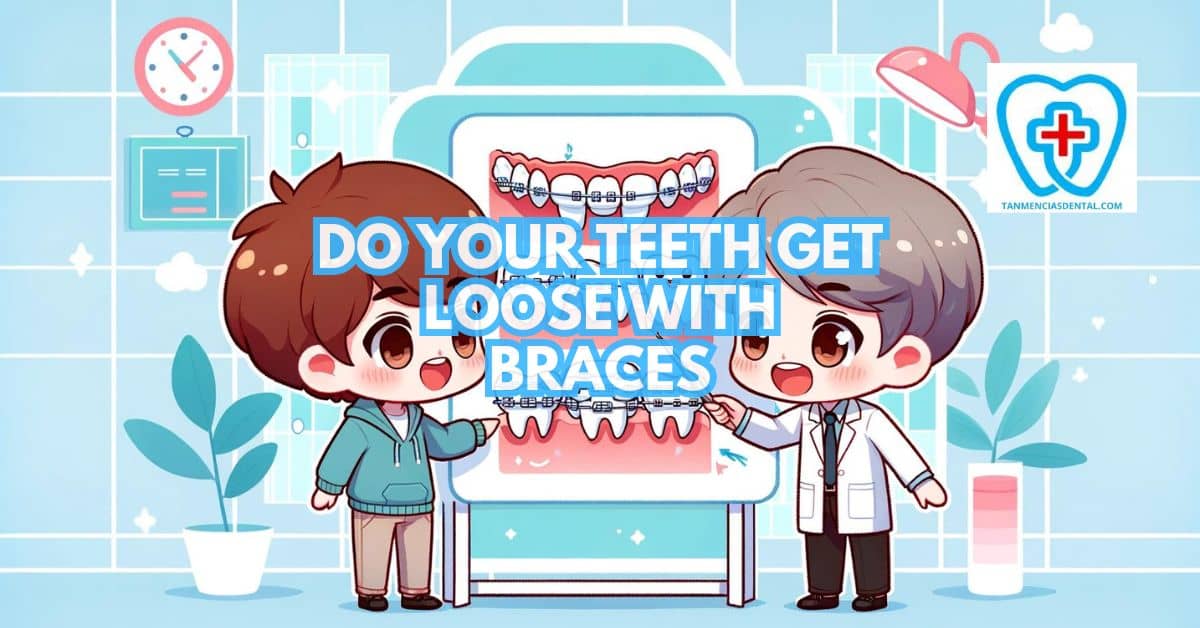Many people ask, “Do your teeth get loose with braces?”
The short answer is yes, but it’s usually temporary and completely normal.
Braces move your teeth by gently pushing them into new positions, and this movement can make them feel a bit loose.
The feeling of looseness means the treatment is working and your teeth are shifting properly.
We’ll explain why that happens, what to expect during treatment, and how your orthodontist keeps the process safe.
1. How Braces Move Teeth: Understanding the Pressure Process
Braces work by using steady, gentle pressure to slowly guide teeth into better positions.
This pressure comes from wires and brackets that are carefully placed and adjusted during each visit.
As the teeth shift, the bone around them breaks down slightly on one side and builds up on the other, a natural process called bone remodeling.
This is why many people notice that their teeth feel loose with braces, especially in the early stages of treatment.
The looseness is temporary and part of how orthodontic treatment helps the teeth move safely.
Orthodontists monitor this process closely to make sure the pressure is not too strong or too weak.
Understanding how pressure affects your teeth can help you feel more comfortable with the steps involved in orthodontics.
🦷 Dental Implants vs. Other Tooth Replacements: Which Is the Better Investment?
2. Temporary Looseness: A Sign Your Braces Are Working
Feeling your teeth become slightly loose with braces is normal.
This looseness indicates that your braces are effectively moving your teeth.
The pressure from the braces stimulates the bone remodeling process.
As your teeth shift, the bone around them dissolves in some areas and builds up in others.
This temporary looseness is a positive sign that your treatment is progressing as planned.
🦷 Close the Gap: How Fixing Your Front Teeth Can Boost Your Confidence and Smile
3. Why It’s Normal to Feel Wiggly Teeth With Braces
When braces apply pressure, it causes the teeth to move slowly through the bone.
This movement stretches the periodontal ligament, a soft tissue that connects each tooth to the surrounding bone.
As the ligament stretches, it creates space for the tooth to shift, which can cause the teeth to feel loose or wiggly.
This looseness is a normal part of orthodontic treatment and usually happens during the early phases of tooth movement.
The feeling may come and go as your braces are adjusted over time.
After your braces are removed, a retainer is used to hold the teeth in their new positions while the bone and ligament fully heal and settle.
Your orthodontist will check the amount of movement at every visit to make sure everything is progressing safely.
🦷 Eco-Friendly Toothbrushes: The Green Revolution in Oral Hygiene
4. The Timeline of Tooth Looseness During Treatment
Tooth looseness usually occurs early in the treatment process.
As your braces start to apply pressure, you’ll notice your teeth becoming slightly loose within the first few weeks.
This looseness is typically most noticeable during the initial phase, when significant movement occurs.
Over the next few months, as teeth settle into their new positions, the looseness gradually decreases.
By the end of your treatment, your teeth will feel secure and stable again.
🦷 Switch to an Eco-Friendly Electric Toothbrush: A Simple Step to Reduce Your Carbon Footprint

5. From Loose to Secure: How Bone Rebuilds Around Your Teeth
After the initial movement, your body starts the process of rebuilding bone around your teeth.
This process, known as bone remodeling, involves resorption of bone in some areas and formation in others.
As the bone rebuilds, it provides a strong foundation for your newly positioned teeth.
This transition from loose to secure takes time but is essential for the stability of your teeth.
Proper care and following your orthodontist’s instructions can help ensure this process goes smoothly.
🦷 The Top Foods and Drinks to Avoid for a Healthier, Stronger Smile
6. How Age and Bone Health Affect Tooth Movement With Braces
Younger people usually have softer bones, which makes it easier for their teeth to move with braces.
Older people may have harder bones, so their teeth can take longer to shift.
Bone health also matters—if the bones around the teeth are weak, tooth movement may be slower or harder to control.
Healthy bones help braces work better and keep the teeth stable during treatment.
Your orthodontist will check your age and bone health to plan the safest and most effective treatment.
🦷 The Future of Dental Exams: How Technology Is Changing the Way We Keep Our Teeth Clean
7. Loose Teeth vs. Extremely Loose Teeth: When to See Your Orthodontist
Slight looseness is expected, but extremely loose teeth can be a concern.
If you notice a tooth that feels very wobbly or unstable, it’s important to consult your orthodontist.
Extremely loose teeth might indicate an issue with the braces or an underlying dental problem.
Your orthodontist can assess the situation and make necessary adjustments to your treatment.
It’s better to address any concerns early to prevent potential complications.
🦷 Choosing the Right Orthodontic Clinic in Marikina: A Guide to Finding the Best Care
8. Keeping Your Smile Healthy: Oral Hygiene During Braces
Maintaining good oral hygiene is crucial when you have braces.
Braces can trap food particles and make cleaning your teeth more challenging.
Brush your teeth at least twice a day, and use floss or interdental brushes to clean between your teeth and around brackets.
Regular dental checkups are also important to monitor your oral health.
Keeping your mouth clean helps prevent gum disease and tooth decay, which can affect tooth stability.
🦷 The Latest Innovations in Toothbrushes: What You Need to Know About Modern Dental Care
9. Dietary Adjustments for Comfortable Braces
Certain foods can exacerbate tooth looseness or cause discomfort while wearing braces.
Avoid hard, sticky, or chewy foods that can put extra pressure on your teeth and damage your braces.
Opt for softer foods like yogurt, mashed potatoes, and soups, which are easier on your braces and teeth.
Cutting food into smaller pieces can also make eating more comfortable.
These adjustments help ensure that your braces work effectively without causing unnecessary pain or damage.
🦷 Oral Prophylaxis: Your Key to Preventing Gum Disease and Keeping Your Gums Healthy
10. Managing Discomfort: Tips for Pain Relief With Braces
It’s common to experience some discomfort when you first get braces or after adjustments.
Over-the-counter pain relievers like ibuprofen can help manage this discomfort.
Orthodontic wax can be applied to brackets and wires that irritate the mouth.
A cold compress can reduce swelling and numb the area, providing relief.
Following your orthodontist’s advice and using these simple remedies can make the treatment process more comfortable.
🦷 How Much Does It Really Cost to Fix a Chipped Tooth? Understanding Your Options
11. The Reward of a Straight Smile: Strong, Securely Positioned Teeth
The temporary looseness and discomfort you experience during treatment are small prices to pay for a beautifully aligned smile.
Once your braces are removed, your teeth will be strong and securely positioned.
The end result is not just an aesthetically pleasing smile but also improved oral health.
Straight teeth are easier to clean and less prone to cavities and gum disease.
The benefits of a straight smile last a lifetime, making the orthodontic journey worthwhile.
🦷 Family Dental Care Clinic in Marikina
👨⚕️ Conclusion
Tooth looseness with braces is a normal part of the orthodontic process.
Understanding this helps you manage expectations and embrace the journey to a straighter smile.
Trust your orthodontist and practice good oral care to ensure the best outcome.
The temporary challenges are worth it for the long-term benefits of a healthy, beautiful smile.
Embrace the process and look forward to the rewarding results.
😊 Self-Promotion
Visit Tan-Mencias Dental Clinic in Parang, Marikina City, for top-notch dental care.
Our friendly team is ready to help with all your dental needs.
Have questions or concerns?
You can easily reach us by calling 9171451074, communicating with us via our Facebook page, or using our website’s contact form.
We look forward to giving you a healthy, beautiful smile!

